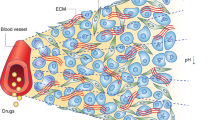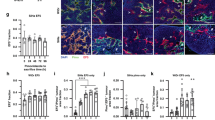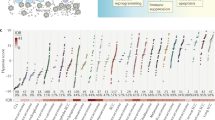Abstract
The tumour blood flow inhibitor 5,6-dimethylxanthenone-4-acetic acid (DMXAA) causes dramatic haemorrhagic necrosis in murine tumours, but activity is seen only at doses close to the toxic limit. This study investigates two approaches for increasing the therapeutic ratio of DMXAA. The first approach combines DMXAA with a second tumour blood flow inhibitor, 5-hydroxytryptamine (5-HT). Co-administration of 5-HT (700 micromol kg(-1)) to C3H mice caused marked enhancement of DMXAA effects against MDAH-MCa-4 tumours, with dose-modifying factors (DMFs) of >3 for blood flow inhibition (at 4 h), 2.3 for necrosis (at 12 h) and 2.0 for growth delay, without compromising the maximum tolerated dose of DMXAA (90 micromol kg(-1)). The data are consistent with ischaemic injury to the tumour being the major mechanism of anti-tumour activity. The second approach combines DMXAA (+/- 5-HT) with hypoxia-selective bioreductive drugs. Anti-tumour activity of all three bioreductive drugs tested (tirapazamine, CI-1010, SN 23816) was strongly potentiated by DMXAA, suggesting that there is a population of reversibly hypoxic tumour cells after DMXAA treatment. Co-administration of 5-HT further potentiated anti-tumour activity, but also increased host toxicity of tirapazamine and CI-1010 so that little therapeutic benefit was achieved. In contrast, the host toxicity of the dinitrobenzamide mustard SN 23816 was only slightly increased by DMXAA/5-HT, whereas the tumour growth delay at the maximum tolerated dose of SN 23816 was increased from 3.5 to 26.5 days. This study demonstrates that 5-HT and/or bioreductive drugs can improve the therapeutic activity of DMXAA in mice, and that with SN 23816 both approaches can be used together to provide considerably enhanced anti-tumour activity.
This is a preview of subscription content, access via your institution
Access options
Subscribe to this journal
Receive 24 print issues and online access
$259.00 per year
only $10.79 per issue
Buy this article
- Purchase on Springer Link
- Instant access to full article PDF
Prices may be subject to local taxes which are calculated during checkout
Similar content being viewed by others
Author information
Authors and Affiliations
Rights and permissions
About this article
Cite this article
Lash, C., Li, A., Rutland, M. et al. Enhancement of the anti-tumour effects of the antivascular agent 5,6-dimethylxanthenone-4-acetic acid (DMXAA) by combination with 5-hydroxytryptamine and bioreductive drugs. Br J Cancer 78, 439–445 (1998). https://doi.org/10.1038/bjc.1998.512
Issue Date:
DOI: https://doi.org/10.1038/bjc.1998.512
This article is cited by
-
Plant-derived vascular disrupting agents: compounds, actions, and clinical trials
Phytochemistry Reviews (2014)
-
Identification of human-selective analogues of the vascular-disrupting agent 5,6-dimethylxanthenone-4-acetic acid (DMXAA)
British Journal of Cancer (2013)
-
Dissection of stromal and cancer cell-derived signals in melanoma xenografts before and after treatment with DMXAA
British Journal of Cancer (2012)
-
Dependency of the effect of a vascular disrupting agent on sensitivity to tirapazamine and γ-ray irradiation upon the timing of its administration and tumor size, with reference to the effect on intratumor quiescent cells
Journal of Cancer Research and Clinical Oncology (2006)
-
Disrupting tumour blood vessels
Nature Reviews Cancer (2005)



